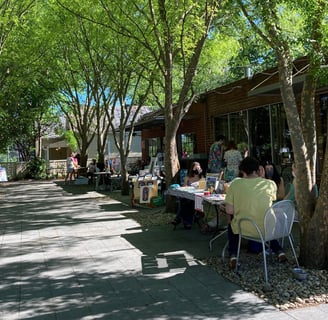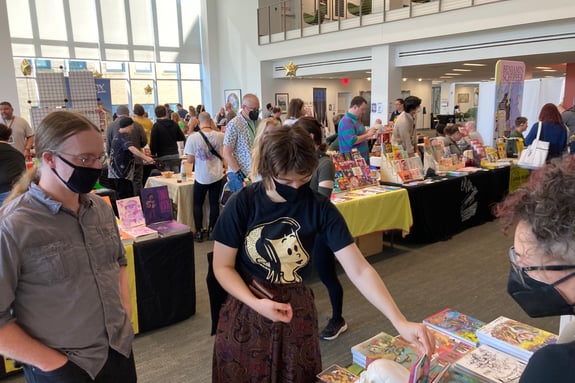Tabling
Beginner tips for tabling at events and markets
TIPS & TRICKS


Tabling is the way for artists to get their work directly into the hands of people. Whether you’re at a farmer’s market, craft fair, artist market, holiday market, zine fest, comics expo, etc., tabling is a great way to build up your audience while also making some money. Some folks build their whole art career around markets and tabling, others just do it when they can. This article is more for beginners just getting started, but if you’re a seasoned pro, please leave some feedback and tips from your experience in the comments below.
How to find a table
You’ve got your art made, maybe you have a pile of stuff ready to go, or you need a deadline to help you prepare your wares. Ideally, you want to table at an event that best matches your craft. If you’re a zinester, zine feats and punk flea markets are great. If you’re making cool paintings, maybe an artist market or farmer’s market is the best option. Start your search by what’s available in your area.
Next, determine your budget. Does the market have crazy expensive registration fees? If you’re just starting out, maybe go for a market that you feel confident you can make back your investment on. If it’s regularly recurring in your community, try attending it before applying to see what the turnout is like.
Also when applying, be sure to see what your registration includes. Do they provide a table or a tent or do you need to bring your own? Is it indoor or outdoor or both? Are there guidelines or rules on how big your display can be? Is it a full table or a half table? Do you need a vendor license?
Table essentials
If you plan to table a lot, it doesn’t hurt to go ahead and buy a 6 ft folding table, a tablecloth, and some kind of rolling cart or suitcase.
As far as displays and signage go, I prefer the minimal route. I personally don’t like the cage displays or large vinyl banners and signage, especially for small press expos or zine fests, but I like being able to reach around my table and chat with folks. Other people would rather have their art do all the talking and let their table be top heavy with display shit. Whatever your preference is, I like the policy of being considerate to my neighbors and not having so much that my table towers over someone else’s, but that kind of depends on the event and how much space you have. An artist market might give you a giant booth all to yourself, but a zine fest might have a ton of tables crammed next to each other.
How you set up your table should make sense for the material you’re selling. If it’s books, little easels are great. If it’s ceramics, maybe you want some boxes in varying sizes to stage pots and use vertical space to maximize the surface area of your table. Practice your set up at home if you want, see how shopable and approachable it looks.
Price your items in advance so you can either label your wares individually, or have a price menu ready for your table. If you have a lot to keep track of, it never hurts to jot down an inventory.
Other things to have: paper, sharpies, scotch tape, scissors in case you need to make impromptu signage.
Making Sales
You’ll need some way(s) to sell your items and take payment. This could look like apps such as Venmo, PayPal, or CashApp, taking card with Square, or just using cash. It’s probably best to have some combination of all those options so you can make purchasing easier on the customer.
Personally, I like to have print outs of QR codes for my payment apps taped to my table, a square reader, and cash to make change.Additionally, depending on how much you’re selling and what apps you’re using, you might want to consider your local state and/or city sales tax. Refer to our blog post on taxes for more context on taxes, but if you’re doing markets full time, you’ll probably want to read up on paying monthly sales taxes in addition to your quarterly tax payments.
Now, the sales part - engaging with customers. Sometimes your art may be able to speak for itself, but usually at a fest or a market, some folks might engage with you and want to know more about how and why you’re making what your making. Some folks love to be sold on something, others might just resonate with the aesthetic of your art and buy it without any storytelling or shop talk. Either way, it’s helpful to have a short spiel to spit when someone approaches your table or booth.
If your art or ware can be picked up, touched, or flipped through, it’s helpful to tell
potential customers it’s okay for them to do so! You want them to be able to engage with your art and form a connection with it.
Getting through the event
No matter what kind of event you’re tabling at, you’re probably signed up for be there for up to 5-8 hours. Make a plan to bring some extra water, snacks, or lunch. If you need to sit, bring a comfy seat if there isn’t one provided at your event. It’s even better if you have a buddy to table with you or visit you during the event so you can take a break to use the restroom, stretch your legs, and take a breather. If you’re tabling alone, make sure you take your cash with you or get it locked up and hidden if you need to step away for a break.
If you’re traveling to table, maybe scout out the area on Google maps and see what restaurants or cafes are around so you can plan to acquire sustenance if and when needed. This can also be helpful for trying to figure out cost-effective and convenient parking, especially when you’re tabling somewhere you’ve never been before.
Outdoor vs. Indoor & Seasonal Events
No matter what time of the season it is, bringing some kind of tent for an outdoor event is a good idea. Sunglasses and sunscreen as especially good to have with you on a bright, sunny day. Indoor events might have some temperature and comfort considerations as well if the space has a lot of windows or is on the second floor of a two-story building (heat rises, sun beams through windows). So preparing to have a couple layers can also come in handy.
Now, with seasonal markets, and this is purely based on my experience - I don’t think people will buy as much if they’re out at a hot summer-day market. Every winter/holiday market I’ve done has turned out with higher sales and sometimes inventory sell outs. Part of that, of course, is people buying gifts for the gift-giving season, but I think the argument of buying something on a cold day versus carrying something around on a sweaty day speaks for itself. Maybe your experience has been different, but this is just my observation. I love events that are in the spring, fall, or winter. No matter when you’re tabling, it’s good to look at the weather and consider the time of year, especially if your event is outside.


Tabling Tips for Beginners
Hopefully that's enough to get you started! If you haven't tabled before, maybe give it a try! Events can also be a great way to meet and connect with other artists and get inspiration for your work.
As usual, if you have a story or resource to share, drop us a line! We'd love to hear your perspective.
